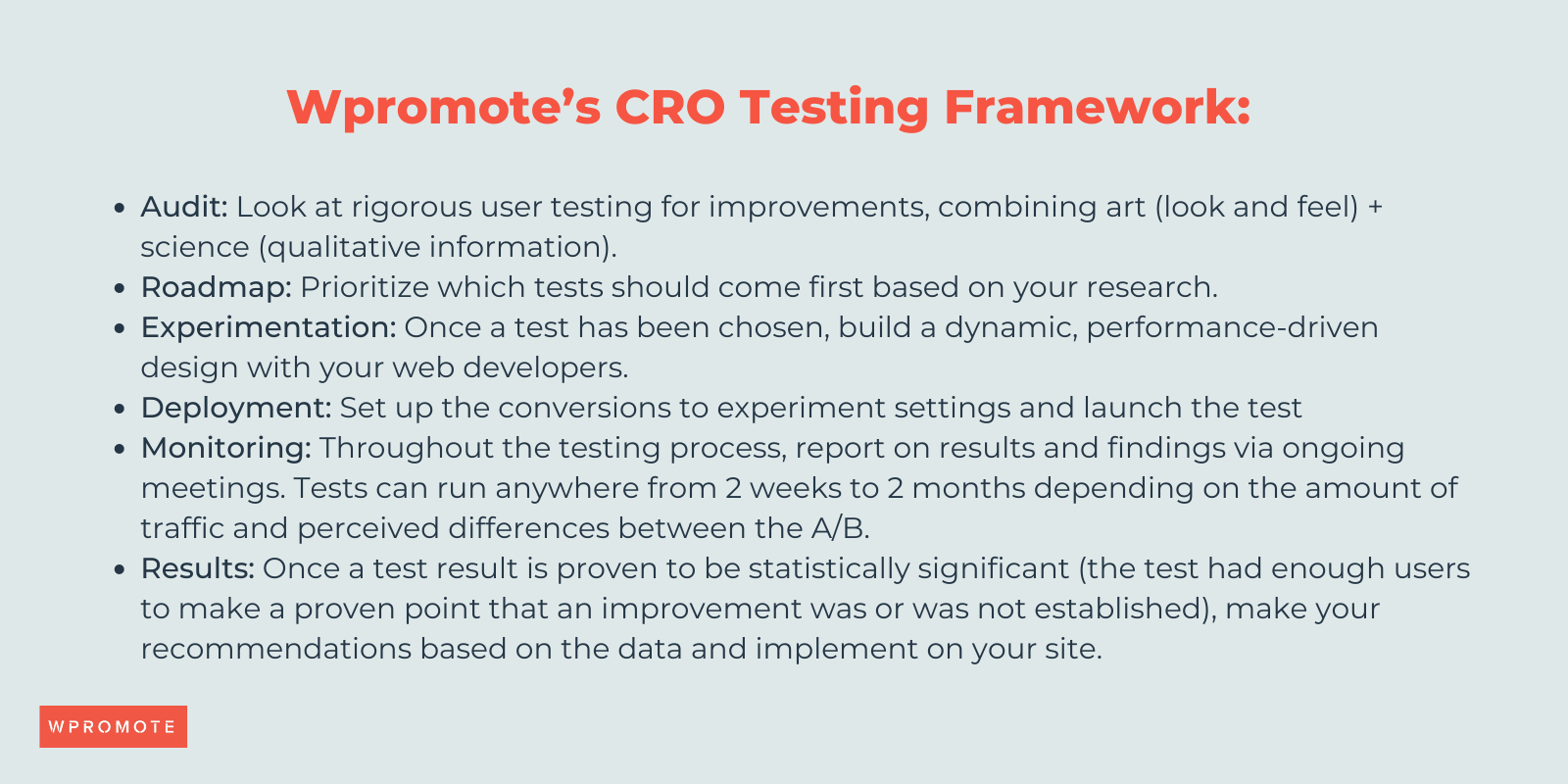Most marketers are laser-focused on driving as much traffic to their brand’s website in the hopes of turning new visitors into qualified leads or customers and driving revenue.
But what if we told you there’s a way to get more out of your existing website traffic and set your business up for long-term, sustainable growth and profitability?
Enter conversion rate optimization (CRO).
What is conversion rate optimization?
CRO is the process of utilizing web analytics and UX research along with iterative, data-driven A/B testing to better understand customer behavior and significantly improve website KPIs like purchases, add-to-carts, leads, email submissions, and more.
Establishing which KPIs are most important to your business requires a deep understanding of your customer personas, your industry, and the individual goals of your company. Here are three commonly-used formulas you can use to calculate some key KPIs that are often the focus of a CRO strategy:
Conversion Rate
Divide your number of conversions (or leads generated) by your number of visitors (or web traffic), then multiply that number by 100 to get the percentage.

Net New Customer Goal
Divide your net revenue goal by your average sales price.

Lead Goal
Divide your number of new customers by your lead-to-customer close rate (which is your total number of leads divided by total number of customers) percentage.

While businesses are always looking for ways to improve conversion rates, there are some common errors that many organizations continue to make that make it less likely visitors will take desired actions. Here are some of the top mistakes/misconceptions to avoid:
- Not making data-driven decisions: Businesses have access to large volumes of data, but many of the teams involved in improving CRO often rely on their own gut or assumptions. This over-reliance on instinct can be detrimental: there’s a treasure trove of data out there—accessible, actionable data that can tell you what is leading people to convert and what isn’t. Rather than piling everything onto your landing pages and hoping for the best, use data as your source of truth to optimize against your conversion goals.
- Misleading content: Content is an integral part of converting any visitor. But when companies choose to use misleading content, it can backfire and alienate visitors. Some of the biggest contributors to low conversion rates are poorly written or misleading page titles, headlines, or links. If a visitor clicked on a link to find a piece of content and that content doesn’t actually address their concerns, or is poorly written, it can negatively impact conversions.
- Using generic CTAs: Having a call to action (CTA) instructs a visitor to take the next desired step and is a great way to improve conversion rates. But no matter how fast your page loads, how beautiful your design, or how catchy your headline—if your call to action is dull and uninspiring, it likely won’t grab people enough to click it and make the conversion.
- Prioritizing products over people: There is a common misconception that CRO simply means moving elements around on a landing page to drive conversions. But truly effective CRO requires a deep understanding of how people make decisions. Ask yourself, “Why do you think customers choose to buy from you and not from your high-converting competitors?” While most businesses assume the answer is their product’s innovative new features or competitive pricing, that’s not how customers make purchasing decisions. The typical customer doesn’t care that you’re number one in your industry, or that you’ve just released an exciting new feature—they care about the why. When you’re trying to convert potential leads into sales, we recommend focusing on the desired outcome and value for the customer, which can help incentivize engagement.
How websites benefit from CRO
Conversion rates help explain what factors drive visitors to your website, and whether or not you are correctly engaging those visitors and delivering a great user experience. CRO helps you not only uncover opportunities to increase sales or downloads of your products, but also make continuous website optimizations that enhance the overall customer experience and improve the efficiency of all marketing efforts across channels.
These small, incremental improvements stack up over time, and ultimately impact your overall business growth and profitability. Here are four areas of your website that have the potential to make a major impact from conversion rate optimization.
- Homepage: Homepages are prime candidates for CRO. In addition to making a first impression on visitors, your homepage is also an opportunity to retain those visitors and guide them further into your website. You can do this by emphasizing links to product information, offering a free signup button, or incorporating a chatbot that solicits questions from visitors at any point during their browsing experience.
- Pricing Page: Your website’s pricing page can be the make-or-break point for many website visitors. CRO can help a pricing page convert visitors into customers by modifying the pricing intervals (e.g. price-per-year vs. price-per-month), describing the product features associated with each price point, and including a phone number for visitors to call for a price quote.
- Blog: A blog is a massive conversion opportunity for your website. In addition to publishing thoughtful and helpful content about your industry, a blog can use CRO to convert readers into leads. This process often includes adding calls-to-action (CTA) throughout an article or inviting readers to learn more about a topic by submitting their information in exchange for an ebook or industry white paper.
- Landing Pages: Landing pages are inherently designed for people to take action. An event landing page, for example, can be optimized with a video of last year’s event to encourage visitors to register this year. And if a landing page is being used to share a free resource with visitors, it can be optimized with preview content from that resource to encourage visitors to download it.
Now that you know where you can optimize for conversions, you may be wondering how you know when your business is ready to start the process.
When is CRO right for your business?
Simply put, if your business is attracting website visitors, then you should take CRO into consideration. That’s because, no matter how established or large your company is, you likely want to convert your visitors into qualified leads, customers, and brand advocates—and do so in the most effective, impactful, and reliable way possible.
With the process of conversion rate optimization, you’ll get more out of your existing website traffic while ensuring you’re targeting qualified leads. Here are a few of the top characteristics that make for the perfect CRO candidate (if you’re not already doing it):
- Your company’s website is too entrenched, with several systems built on top of one another, making it impossible (or highly difficult) to carry out simple website optimizations or tweaks
- You have a standout, viral product that’s generating interest, but you lack the necessary in-house marketing expertise to carry out dedicated testing and optimizations
- All efforts of your company are focused on keeping up with demand instead of improving your website and enhancing the overall user experience to drive ROI
Key CRO Best Practices
We recommend approaching CRO using these three guiding principles:
- CRO Should Be Data-Driven, Not Just Data-Informed
- At its core, CRO needs to be based on relevant, real-time data. Specifically, this means using data to test hypotheses through to results.
- Determine the right KPIs to help you accurately measure a test’s success, not just conversions or traffic. This will sometimes call for additional tagging or metric creation.
- Having a data science and analytics engineering team from the start can vastly improve your ability to unlock data, increase agility, and scale at speed.
- Get Creative About Solutions
- You’re never going to achieve long-term conversion success from a single change. The best way to improve your CRO strategy is to get creative and implement a series of iterative changes based on your audience’s actions: where they’re going, what they’re doing, and why.
- There are oftentimes aspects of your website that you do not want to change (for whatever reason). But to achieve true CRO success, you must not shy away from making improvements that challenge the status quo and flip these notions on their head.
- Look at Full-Funnel Performance
- Conversion rate optimization is not just about improving click-throughs on landing pages. On the contrary, there are opportunities to improve at every stage throughout the funnel.
- By optimizing the on-site experience, you inherently impact everything from prospecting all the way through the post-purchase/lead customer lifecycle—maximizing the efficiency of all marketing efforts across channels.
Make the business case for CRO
To prove the business value of CRO, it’s important to drive home the fact that conversion rate optimization is an investment of your time—not your ad dollars. You don’t have to change anything about your marketing strategy, and you don’t have to pay for more traffic: you’re simply making that traffic work harder by increasing the number of existing users who convert to drive higher ROI.
CRO marketing is not a one-time activity but an ongoing process. CRO is truly a win-win: it helps all of your marketing channels convert better and boosts performance across the funnel. So go on, and embark on this exciting journey. Here’s to full-funnel optimization!








Responses